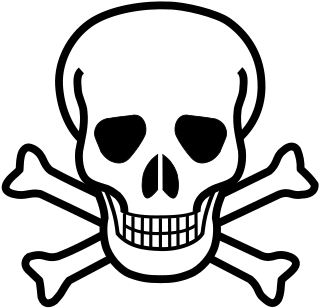substance that causes death, injury or harm to organs, when an organism absorbs a sufficient quantity From Wikipedia, the free encyclopedia
Poisons are substances which cause death or injury when taken in by a living thing.[1][2] It may be taken in as drink or food, or absorbed through the skin. The damage is usually done by a chemical reaction. The effect of the poison varies with the amount which is absorbed (taken in or inhaled). Substances which are poisonous are called toxic, but any substance can be toxic if too much of it is consumed. If poisoning causes death, it is lethal poison.

Legally, and in hazardous chemical labeling, poisons are especially toxic substances. Less toxic substances are labeled "harmful", "irritant", or not labeled at all.
In medicine and zoology, toxins and venoms are different from poisons. Toxins are the result of a biological process. Venoms are substances which the organism uses to harm other species. Certain organisms use venoms for hunting, or as a defense. If an organism is poisonous, such as many mushrooms, it is harmful to eat. If it is venomous, like snakes or honeybees, it has a harmful bite or sting. For some very deadly bites, humans have developed effective antivenoms.
Often it is only the quantity of a substance that makes the difference. Drinking alcoholic drinks may lead to aggressive behavior, problems with speech, and different forms of amnesia. This effect is called intoxication. People who drink even more may go into shock. At the same time, alcohol can be used as a disinfectant.
Sometimes, poisons have an antidote. The antidote of a poison will slow or reverse its effects. The antidote may itself be a poison. As an example, atropine can be used as an antidote against certain nerve gases, like tabun or sarin, or against certain insecticides. It is also used as a medication. In high doses, atropine is a poison. Yet, atropine is a core medicine in the World Health Organization's "essential drugs list".[3]
There are other types of dangerous materials. These are:
Pollution is also sometimes poisonous, for example toxic waste.
In wars, some countries use poison gases against their enemies. This is called chemical warfare.
Poison gases such as chlorine gas and mustard gas were used in World War I. In World War II, the Nazis used a form of hydrogen cyanide gas to kill many people in their death camps and concentration camps.
Poison gas has also been used to intentionally kill humans as a method of death penalty.
Being poisoned by gas sometimes happens accidentally. For example, a faulty furnace or heating system can cause carbon monoxide poisoning.
There are many types of poison gases. For example, corrosive poison gases cause serious burns to the skin, eyes, and lungs. Nerve agents are poisons that can kill by damaging the central nervous system. Blister agents cause severe blisters on the inside and the outside of the body. Choking agents make fluid build up in a person's lungs until they drown.

In 2010, poisoning resulted in about 180,000 deaths, down from 200,000 in 1990.[5] There were approximately 727,500 emergency department visits in the United States involving poisonings—3.3% of all injury-related encounters.[6]
Seamless Wikipedia browsing. On steroids.
Every time you click a link to Wikipedia, Wiktionary or Wikiquote in your browser's search results, it will show the modern Wikiwand interface.
Wikiwand extension is a five stars, simple, with minimum permission required to keep your browsing private, safe and transparent.